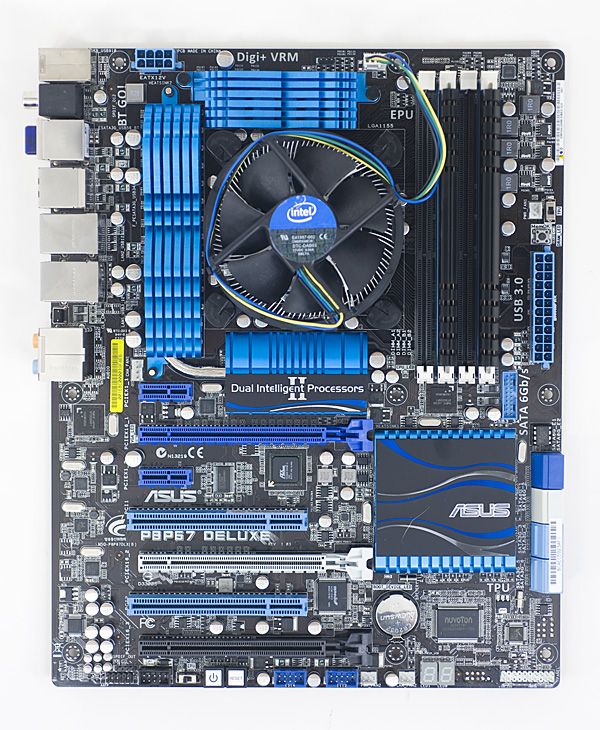The Sandy Bridge Review: Intel Core i7-2600K, i5-2500K and Core i3-2100 Tested
by Anand Lal Shimpi on January 3, 2011 12:01 AM ESTUEFI Support: 3TB Drives & Mouse Support Pre-Boot
Remember the mountain of issues I had trying to get Seagate’s 3TB HDD to work as a boot drive in my X58 system? A couple of weeks ago Intel released version 10.1 of its storage drivers, which added software support for drives larger than 2.2TB. That’s one piece of the puzzle. With Sandy Bridge, many motherboard manufacturers are moving to UEFI instead of traditional 32-bit PC BIOSes. Combine that with a GPT partition and your new Sandy Bridge system should have no problems booting to and accessing 3TB drives made of a single partition.

ASUS' entire SNB lineup is UEFI enabled
ASUS sent over a couple of its 6-series motherboards which boast a custom skinned UEFI implementation. You get all of the functionality of a traditional BIOS but with a GUI, and yes, there’s full mouse support.
You’re either going to love or hate the new UEFI GUIs. They do take a little time to get used to but pretty much everything is where you’d expect it to be. Navigating with the mouse can be quicker than the keyboardin some situations and slower in others. Thankfully the interface, at least ASUS’, is pretty quick. There’s scroll wheel support although no draggable scroll bars, which makes quickly scrolling a little frustrating.
Unlike P55, you can set your SATA controller to compatible/legacy IDE mode. This is something you could do on X58 but not on P55. It’s useful for running HDDERASE to secure erase your SSD for example. If you do want to use HDDERASE on a 6-series motherboard you’ll need to first run HDDERASE4 to disable the UEFI initiated security on your drive and then run HDDERASE3 to secure erase it.
The biggest improvement to me honestly is POST time. Below is a quick comparison of time from power on to the Starting Windows screen. I’m using the exact same hardware in all three cases, just varying motherboard/CPU:
| Intel P67 | Intel P55 | Intel X58 | |
| Time from Power on to Boot Loader | 22.4 seconds | 29.4 seconds | 29.3 seconds |










283 Comments
View All Comments
IanWorthington - Monday, January 3, 2011 - link
Not really: the board manufacturers seem to be adding usb3 chipsets w/o real problems. Good enough.usernamehere - Monday, January 3, 2011 - link
Sure, if you're building a desktop you can find plenty with USB 3.0 support (via NEC). But if you're looking for a laptop, most will still not have it. For the fact that manufacturers don't want to have to pay extra for features, when they usually get features via the chipsets already included. Asus is coming out with a handful of notebooks in 2011 with USB 3.0 (that I know of), but wide-spread adoption will not be here this year.JarredWalton - Monday, January 3, 2011 - link
Most decent laptops will have USB3. ASUS, Dell, HP, Clevo, and Compal have all used the NEC chip (and probably others as well). Low-end laptops won't get USB3, but then low-end laptops don't get a lot of things.TekDemon - Monday, January 3, 2011 - link
Even the netbooks usually have USB 3.0 these days and those almost all use intel atom CPUs. The cost to add the controller is negligible for large manufacturers. USB is not going to be the deciding factor for purchases.DanNeely - Monday, January 3, 2011 - link
Are you sure about that? Newegg lists 99 netbooks on their site. Searching for USB 3 within netbooks returns 0 products.TekDemon - Monday, January 3, 2011 - link
Your claims are pretty silly seeing as how USB came about in the same way that Light Peak did-Intel invented USB and pushed it to legacy ports like PS/2, and slowly phased out support for the older ones entirely over the years. It makes no sense for them to support USB 3.0, especially without a real market of devices.But motherboard manufacturers will support USB 3.0 via add-in chips. I don't see how this anti-competitive at all, why should intel have to support a format it doesn't think makes sense? So far USB 3.0 hasn't really shown speeds close to it's theoretical, and the only devices that really need the higher bandwidth are external drives that are better off being run off E-SATA anyways. There's no real "killer app" for USB 3.0 yet.
BTW Light Peak will easily support adding power to devices, so it definitely does not need USB in order to provide power. There'll just be two wires running alongside the fiber optics.
DanNeely - Tuesday, January 4, 2011 - link
The eSata + USB (power) connector has never gone anywhere, which means that eSata devices need at least 2 cables to work. Flash drives and 2.5" HDs don't need enough power to require an external brick, and 80-90% of eSata speed is still much better than the USB2 bottleneck. With double the amount of power over USB2, USB3 could theoretically be used to run 3.5" drives with a double socket plug freeing them from the wall as well.ilkhan - Monday, January 3, 2011 - link
I've had my P67A-UD4 for almost 3 weeks now. Lets get the chips out already!I'm confused, however. The fist paragraph talks of 4.1Ghz turbo mode and the chart on page 2 lists 3.8Ghz as the max for the 2600K. Is the chart talking about 4-core turbo or what?
Spike - Monday, January 3, 2011 - link
Isn't it an i7-2600k? The article title says "i5 2600k"... just curious...Ryan Smith - Monday, January 3, 2011 - link
Oh dear...Fixed. Thanks for that.